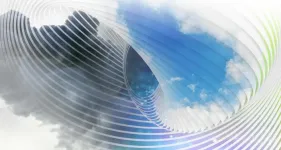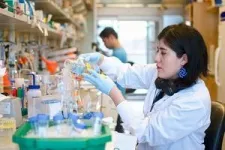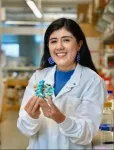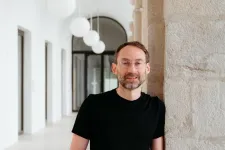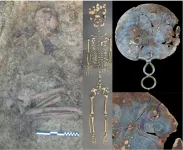(Press-News.org) Arizona State University and a team of its collaborators have received $11.2 million in funding from the U.S. Department of Energy to begin developing a regional Direct Air Capture (DAC) Hub for removing carbon dioxide (CO2) from the atmosphere. The team will prepare to build a multi-site Direct Air Capture Hub located in the Four Corners area of the Southwestern United States. Additionally, the project will receive $11.2 million in matching funds from the project partners.
In May of 2022, the Biden administration announced the Bipartisan Infrastructure Law’s $3.5 billion DOE program to establish large-scale Direct Air Capture Hubs for removing carbon pollution from the air. ASU and its collaborators are one of five Topic Area 2 - Design Hubs supported across the country.
“Direct air capture is now a necessity if we are to manage CO2 levels in the atmosphere,” said Gary Dirks, ASU principal investigator for the project and senior director with the Julie Ann Wrigley Global Futures Laboratory and director of LightWorks®. “This project lays the foundation for technologies and storage facilities to scale together. At the same time, the project lays the foundation for a new industry that can provide much needed employment and a robust tax base for rural communities.”
The ASU-led team has identified three sites in east-central Arizona, northwestern New Mexico and southeastern Utah as locations for the hub. These sites will use new technologies to capture and remove carbon from the air as well as store the carbon that is collected. Additionally, the sites will use new solar and wind power to support the DAC technology — creating a renewable energy economy in the same region of aging coal plants that are being retired. The team’s goal is to be a testbed for carbon capture, utilization and storage in the southwestern region.
In addition to ASU, key collaborators include Black & Veatch; CarbonCapture Inc..; Carbon Collect Ltd.; Carbon Solutions; Proton Green; New Mexico Tech; University of Utah; Sideporch; Tallgrass Energy; and the Arizona Geological Survey.
“The establishment of Regional DAC Hubs in the U.S. is a pivotal step forward in our nation’s and the world's efforts to scale up direct air capture of carbon dioxide,” said Peter Schlosser, vice provost and vice president of the Global Futures Laboratory at ASU. “In the Four Corners region, ASU has assembled a talented, committed, and innovative team of academic, industry and government partners to remove CO2 from the atmosphere, utilize part of it and sequester the rest into geological reservoirs. It’s going to take all of us, working together with an urgent sense of purpose, to take full advantage of this opportunity to create solutions to the rapidly accelerating climate crisis.”
Direct Air Capture is a concept pioneered by Klaus Lackner, founding director of the ASU Center for Negative Carbon Emissions in the Global Futures Laboratory, and a professor at the School of Sustainable Engineering and the Built Environment with Ira A. Fulton Schools of Engineering. Lackner was the first person (in 1999) to suggest artificial capture of carbon dioxide from air as a way of reducing atmospheric carbon and lessening global warming.
Additionally, ASU is a leader in research and development in DAC technology through its Center for Negative Carbon Emissions. The center is actively exploring sorbents that are commercially available for high capacity, rapid CO2 sorption and release.
In the first phase of this project, the team will develop a plan to use cutting-edge direct air capture technology to remove at least 1 million metric tons of CO2 from the atmosphere each year. The team will complete initial engineering studies for anchoring the DAC systems, develop the infrastructure plan to transport the carbon to the sequestration sites, and develop a storage plan for the three sites that could support at least 12 years of carbon capture.
“This award will enable Arizona State University and Black & Veatch to more quickly advance decarbonization through direct air capture technology,” said Algert Prifti, carbon capture, utilization and storage (CCUS) technology manager for Black & Veatch. “The project will build upon Black & Veatch's more than 30 years of global leadership in CCUS, and it will further enable full-scale commercialization of CO2-reducing solutions around the world.”
The team has also created a “Community Benefits Plan” in which the group will be engaged with local communities, Tribes, state and local governments and other stakeholders to establish a Hub that supports economic development reflecting the cultures, values and natural environments of the region. It will also provide training, conduct STEM outreach, engage with local unions, trade schools and community colleges to develop an educational pathway for the workforce needed to help make the Southwest Regional DAC Hub successful.
“This is an important economic development opportunity for a region that has seen significant job losses due to the closure of coal-fired power plants,” said Lauren Keeler, Community Benefits Lead for the project and director of ASU’s Just Energy Transition Center in the Global Futures Laboratory. “The community benefits plan outlines how communities can be involved in hub planning and decision-making so that community values and community development are central to the hub.”
“The community benefits plan is also about sustainability,” Keeler explained. “Land, water, and energy are all required for the DAC hub. We want to make sure that those resources are used sustainably and that communities have a strong voice in resource decisions.”
The two co-anchor DAC technology companies, Carbon Collect and CarbonCapture, Inc., are bringing direct air capture expertise to the project.
Pól Ó Móráin, CEO and Co-Founder of Carbon Collect Ltd., said: “The allocation of this funding underscores the groundbreaking technology we have developed and our strong collaboration with ASU. The MechanicalTree™, which has been operational at ASU’s Tempe campus, is now advancing toward its Gen-II phase, highlighting our readiness to scale this vital technology in the fight against climate change. This government support allows us to take the next step alongside our partners, marking a key milestone in the evolution of carbon capture.”
"We're extremely excited to deploy our next-generation modular DAC systems as part of ASU's Southwest Regional DAC Hub." said Adrian Corless, CEO, CarbonCapture Inc. “The DAC Hub represents a major opportunity for Arizona to leverage its considerable business-friendly infrastructure, extensive academic research capabilities, and deep renewable energy assets to become a worldwide center of excellence for climate tech. These factors also made Arizona the perfect home for our DAC manufacturing facility, the first of its kind in the world."
The project was awarded in October 2024. If successful, the team will seek to proceed into construction and operation of the Southwest Regional DAC Hub.
END
ASU-led collaboration receives $11.2 million to build a Southwest Regional Direct Air Capture Hub
U.S. Department of Energy funds regional effort to remove CO2 from the atmosphere
2025-01-15
ELSE PRESS RELEASES FROM THIS DATE:
Study finds strategies to minimize acne recurrence after taking medication for severe acne
2025-01-15
Isotretinoin, commonly referred to as Accutane, is the only approved medical treatment capable of inducing long-term remission of severe acne. Although highly effective, some individuals experience recurrence of acne after a course of treatment. A new study from researchers at Mass General Brigham examined how often acne recurs after isotretinoin and what factors might put patients at risk of acne coming back. They found that acne recurrence necessitating treatment with an oral medication such as oral antibiotics, spironolactone, or another ...
Deep learning designs proteins against deadly snake venom
2025-01-15
New proteins not found in nature have now been designed to counteract certain highly poisonous components of snake venom. The deep learning, computational methods for developing these toxin-neutralizing proteins offer hope for creating safer, more cost-effective and more readily available therapeutics than those currently in use.
Each year more than 2 million people suffer snakebites. More than 100,000 of them die, according to the World Health Organization, and 300,000 suffer severe complications and lasting disability ...
A new geometric machine learning method promises to accelerate precision drug development
2025-01-15
Proteins are the foundation of all life we currently know. With their virtually limitless diversity, they can perform a broad variety of biological functions, from delivering oxygen to cells and acting as chemical messengers to defending the body against pathogens. Furthermore, most biochemical reactions are only possible thanks to enzymes, a special type of protein catalysts.
The molecular surface of proteins is the key to their function, such as docking small molecules or other proteins or driving ...
Ancient genomes reveal an Iron Age society centred on women
2025-01-15
An international team of geneticists, led by those from Trinity College Dublin, has joined forces with archaeologists from Bournemouth University to decipher the structure of British Iron Age society, finding evidence of female political and social empowerment.
The researchers seized upon a rare opportunity to sequence DNA from many members of a single community. They retrieved over 50 ancient genomes from a set of burial grounds in Dorset, southern England, in use before and after the Roman Conquest of AD 43. The results revealed that this community was centred around bonds of female-line descent.
Dr Lara Cassidy, Assistant Professor in Trinity’s Department of Genetics, led ...
How crickets co-exist with hostile ant hosts
2025-01-15
Researchers at Nagoya University in Japan have discovered sophisticated behavioral strategies that enable parasitic crickets to survive within ant colonies. Led by Ryoya Tanaka, the team documented how these insects successfully navigate life among potentially lethal hosts through precise evasion tactics. Their findings, published in Communications Biology, reveal remarkable adaptations that allow these cricket species to thrive in a hostile environment.
Animals that live in ant colonies, known as “ant guests”, exploit their hosts’ resources. However, this ...
Tapered polymer fibers enhance light delivery for neuroscience research
2025-01-15
WASHINGTON — Researchers have developed a reliable and reproducible way to fabricate tapered polymer optical fibers that can be used to deliver light to the brain. These fibers could be used in animal studies to help scientists better understand treatments and interventions for various neurological conditions.
The tapered fibers are optimized for neuroscience research techniques, such as optogenetic experiments and fiber photometry, which rely on the interaction between genetically modified neurons and visible light delivered to and/or collected from the brain.
“Unlike standard optical fibers, which are cylindrical, the tapered fibers we developed have a conical shape, which ...
Syracuse University’s Fran Brown named Paul “Bear” Bryant Newcomer Coach of the Year Award recipient
2025-01-15
HOUSTON, January 15, 2025 — The American Heart Association has named Syracuse University’s Fran Brown as the recipient of the 2024 Paul “Bear” Bryant Newcomer Coach of the Year Award. This award celebrates the achievements of an individual who has not had any previous head coaching experience at the NCAA Division I football sub-division (FBS) level.
Coach Brown will be recognized with the honor during the 2025 Bear Bryant Awards on January 22.
After being named Syracuse’s 31st head coach on November 28, 2023, Brown immediately instilled a culture of ...
DARPA-ABC program supports Wyss Institute-led collaboration toward deeper understanding of anesthesia and safe drugs enabling anesthesia without the need for extensive monitoring
2025-01-15
By Benjamin Boettner
(BOSTON) — Currently, no anesthetic compound or cocktail can be used safely outside of a hospital facility. This is because current drugs impair the brain and central nervous system’s ability to regulate a number of vital processes, including respiration, body temperature, and heart rate in addition to creating a state of unconsciousness or sedation, making the strict monitoring of patients with the help of sophisticated instruments and highly-trained clinical personnel an absolute necessity. To reduce trauma associated with injuries and improve combat casualty outcomes, under a new DARPA-ABC contract ...
The Offshore Wind Innovation Hub 2025 call for innovators opens today
2025-01-15
The Offshore Wind Innovation Hub today announced the opening of its 2025 application process, designed to identify and support entrepreneurial and innovative companies that will help unleash the potential of the dynamic emerging offshore wind industry.
Winners take on a six-month mentoring and business development program residency designed to prepare them for strategic partnerships with major offshore wind developers and to be part of the larger offshore wind value chain. The program aims to enable innovators to overcome barriers ...
Aligning Science Across Parkinson’s (ASAP) launches a new funding opportunity to join the Collaborative Research Network
2025-01-15
The Aligning Science Across Parkinson’s (ASAP) initiative opened applications for members of the research community to apply to join the Collaborative Research Network (CRN) 2025 Scientific Track. The new Scientific Track grants will support collaborative research teams focused on dissecting the mechanisms that contribute to Parkinson’s disease (PD) heterogeneity across one of six focus areas listed below, offering funding of up to $3 million per year over three years.
Examining PD in the context of aging
Understanding how co-pathologies can influence PD pathogenesis and progression
Dissecting ...
LAST 30 PRESS RELEASES:
Norbert Holtkamp appointed director of Fermi National Accelerator Laboratory
New agentic AI platform accelerates advanced optics design
Biologists discover neurons use physical signals — not electricity — to stabilize communication
Researchers discover that a hormone can access the brain by hitchhiking
University of Oklahoma researcher awarded funding to pursue AI-powered material design
Exploring how the visual system recovers following injury
Support for parents with infants at pediatric check-ups leads to better reading and math skills in elementary school
Kids’ behavioral health is a growing share of family health costs
Day & night: Cancer disrupts the brain’s natural rhythm
COVID-19 vaccination significantly reduces risk to pregnant women and baby
The role of vaccination in maternal and perinatal outcomes associated with COVID-19 in pregnancy
Mayo Clinic smartwatch system helps parents shorten and defuse children's severe tantrums early
Behavioral health spending spikes to 40% of all children’s health expenditures, nearly doubling in a decade
Digital cognitive behavioral treatment for generalized anxiety disorder
Expenditures for pediatric behavioral health care over time and estimated family financial burden
Air conditioning in nursing homes and mortality during extreme heat
The Alps to lose a record number of glaciers in the next decade
What makes a good proton conductor?
New science reporting guide published for journalists in Bulgaria
New international study reveals major survival gaps among children with cancer
New science reporting guide published for journalists in Turkey
Scientists develop a smarter mRNA therapy that knows which cells to target
Neuroanatomy-informed brain–machine hybrid intelligence for robust acoustic target detection
Eight SwRI hydrogen projects funded by ENERGYWERX
The Lundquist Institute and its start-up company Vitalex Biosciences Announces Strategic Advancement of Second-Generation fungal Vaccine VXV-01 through Phase 1 Trials under $40 Million Competitive Con
Fine particles in pollution are associated with early signs of autoimmune disease
Review article | Towards a Global Ground-Based Earth Observatory (GGBEO): Leveraging existing systems and networks
Penn and UMich create world’s smallest programmable, autonomous robots
Cleveland researchers launch first major study to address ‘hidden performance killer’ in athletes
To connect across politics, try saying what you oppose
[Press-News.org] ASU-led collaboration receives $11.2 million to build a Southwest Regional Direct Air Capture HubU.S. Department of Energy funds regional effort to remove CO2 from the atmosphere
